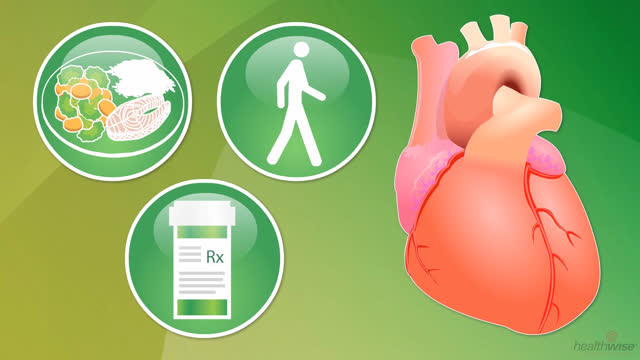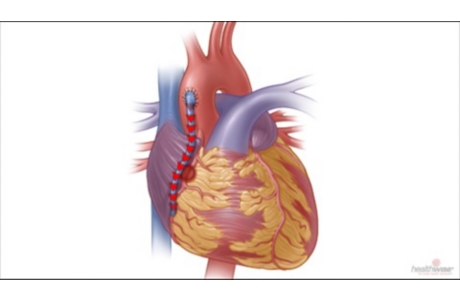Coronary Artery Bypass Graft Surgery: Self-Care for Recovery
Topic Overview

What are your responsibilities during your recovery from bypass surgery?
You have several responsibilities while you are recovering from coronary artery bypass graft (CABG) surgery, including:
- Caring for your wounds.
- Taking your medicines.
- Monitoring your weight.
- Improving your heart and lung health.
- Attending cardiac rehabilitation.
- Making changes in your lifestyle.
Everyone heals at a different rate. But following your doctor’s orders can help you achieve a fast and comfortable recovery.
Settling in at home
It may be worthwhile to keep all of your medical information together and handy during your recovery, including:
- Self-care instructions. These are instructions from your medical team about how to care for yourself. You may want to have a folder or binder to keep this information organized.
- Medicine information. This is a list of all the medicines you are prescribed after you leave the hospital. These medicines might be different from medicines you took before your CABG surgery.
- Contact information. This is a list of the names and phone numbers of your primary care physician, cardiologist, and cardiac surgeon, in case of an emergency. You may also want to keep a calendar with the dates and times of scheduled follow-up appointments.
- Insurance information. This is a card with information on your health insurance coverage, in case you need to return to the hospital. You may want to keep this in your wallet in case you are not at home.
Caring for your wounds
A major aspect of your recovery is caring for the incision (sternotomy) made to open your chest during CABG surgery. Because it is so important that this incision heals properly, many limitations are placed on you during your recovery. You also need to take care of the skin around your arm or leg incisions. All of your incisions need to be taken care of so that they can heal quickly and without infection. Your doctor will likely give you instructions on how to take care of your incision. In general, follow these steps:
- Take a warm (not hot) shower every day.
- Wash the area with warm, soapy water, and pat it dry.
- Inspect your incisions every day.
- Tell your doctor if you notice excessive pain, redness, or swelling or if you have a fever.
Do not:
- Remove the tape from your incisions (it will come off by itself).
- Take baths.
- Scrub or rub your incisions.
- Use lotion or powder on your incisions.
- Overexpose your incisions to sunlight.
Your chest
Your surgeon may cut through your chest bone, or sternum, to perform your CABG surgery. Unlike other bones in your body, your sternum cannot be placed in a cast while it heals. Instead, your surgeon wraps heavy wire around it to hold the edges together. The sternum can heal properly only if the ends are held together constantly for several weeks. Therefore, you should not engage in strenuous activities that could shift the two edges apart during the first 4 to 6 weeks of your recovery.
Two activities that can shift the edges of your sternum apart and so should be avoided are:
- Lifting objects heavier than 5 lb (2.3 kg), including small children, trash baskets, and bikes.
- Driving (even a minor car accident may cause your chest to hit the steering wheel).
Your arm or leg
Your arm or leg incision may be swollen and painful. This results not only from the incision that cut through your skin and muscle but also from losing a blood vessel in your arm or leg that would normally circulate blood in the area of the incision. It will take a little time for your arm or leg to adjust to the missing vessel and for your incision to heal.
To help your arm or leg recover faster and more comfortably, you can:
- Keep your swollen arm or leg elevated.
- Wear special supportive hose (available from your doctor).
Taking your medicines
You will take medicines after your CABG surgery. Your doctor or nurse will give you written instructions for taking your medicines before you leave the hospital. These new medicines may be in addition to or instead of the medicines you were taking before your surgery. Make sure that your doctor or nurse explains very clearly to you what medicines you should be taking.
Sometimes it’s hard to remember to take your medicines. But you can remind yourself by doing things like posting notes where you can see them or using a pillbox.
Watching your weight
It is important to watch your weight very closely after your surgery. A sudden increase in your weight is often a sign of fluid retention. This fluid retention can point to a problem, such as worsening heart function and kidney failure.
To monitor your weight, you should:
- Weigh yourself at the same time every morning.
- Keep a record of your weight.
- Bring your weight record with you when you visit your doctor.
- Call your doctor if you gain 3 lb (1.4 kg) or more in 2 to 3 days.
Improving your heart and lung functions
While you are recovering from your CABG surgery, you will need to work on increasing your physical activity or exercising. You need to become more physically active, because you need to restore your full lung function. You also need to improve the blood circulation throughout your body. This will help your body heal properly.
If you do not exercise, you risk getting blood clots in the blood vessels of your legs. This is a painful condition that can cause several complications, including blockage of a blood vessel.
Walking is an excellent exercise after CABG surgery. Walking is safe and someone else can easily walk with you. Your leg will be sore if your surgeon removed blood vessels from your leg to use during your surgery. Despite this pain, it is important to your recovery that you continue to walk.
Attending cardiac rehabilitation
Cardiac rehabilitation (rehab) programs can start in the hospital or soon after you go home after surgery. Cardiac rehab helps you recover and teaches you how to be more active and make lifestyle changes that can lead to a stronger heart and better health. Cardiac rehab can help you feel better and lower your risk of future heart problems.
A cardiac rehab team often includes a doctor, a nurse specialist, a dietitian, an exercise therapist, and a physical therapist. The team designs a program just for you, based on your health and goals. Then they give you support to help you succeed.
Some tips for exercising after CABG
Work with your doctor and rehab specialist to develop a rehab plan. The following is a general guideline for increasing your exercise:
- Take several walks each day. Spread the walks throughout your day.
- Don’t overdo it: Stop and rest if you get tired.
- Gradually increase the distance and duration of your walks. Add one city block to your walk each week.
- Do not walk by yourself.
- Take stairs at a slow pace.
- Don’t pull on the banisters with your arms to avoid straining the surgery site.
- Don’t do too much all at once.
Although you may be weak, tired, or experiencing chest soreness as a result of your surgery, many people with coronary artery disease (CAD) can work their way back up to normal activity levels by participating in a structured cardiac rehab program or by working with their doctors to develop a home exercise program.
Making changes in your lifestyle
Your doctor probably told you that certain aspects of your lifestyle (such as smoking, an unhealthy diet, or high stress) make your cardiac health worse. Now that you have had your diseased arteries repaired with open-heart surgery, you want to keep your heart as healthy as you can. It is important to keep your new bypass grafts healthy. Your doctors, nurses, or rehabilitation team members can help you take steps to live in a heart-healthy way. You may need to make lifestyle changes. You may need to quit smoking, eat a heart-healthy diet, be active, stay at a healthy weight, and reduce the stress in your life.
Resuming sexual activity
You will be able to resume sexual activity after you recover from surgery. Most people wait about 6 or 8 weeks after surgery.
Some people are afraid to resume sexual activity after a heart attack. They are worried that they will have angina symptoms, such as chest pain or pressure. They worry that they will not have enough energy for sex. They also worry about having another heart attack.
The risk of having a heart attack during sex is low. Sex is the cause of less than 1 out of 100 heart attacks.footnote 1 This risk is low if you can do moderate activity without having angina symptoms.
You can ask your doctor to help you know when your body is healed and healthy enough for sex. If you need help dealing with feelings of worry or fear, you can also try professional counseling.
When you and your partner decide to start having sex again, it might be helpful to keep in mind the following:
- Talk honestly to your partner about your concerns and feelings.
- Choose a time when you are relaxed and comfortable in a place that will be free from interruptions.
- Wait 1 to 3 hours after eating a full meal so that digestion can take place.
- Be aware that anxiety on the part of either partner may interfere with sexual arousal and performance. Talk with your doctor about any concerns.
References
Citations
- Levine GN, et al. (2012). Sexual activity and cardiovascular disease: A scientific statement from the American Heart Association. Circulation, 125(8): 1058–1072.
Other Works Consulted
- Hillis LD, et al. 2011 ACCF/AHA Guideline for coronary artery bypass graft surgery: A report of the American College of Cardiology Foundation/American Heart Association Task Force on Practice Guidelines. Circulation, 124(23): e652–e735.
- Kulik A, et al. (2015). Secondary prevention after coronary artery bypass graft surgery: A scientific statement from the American Heart Association. Circulation, 131(10): 927–964. DOI: 10.1161/CIR.0000000000000182. Accessed April 6, 2015.
- Morris DC, et al. (2011). Management of the patient after cardiac surgery. In V Fuster et al., eds., Hurst’s The Heart, 13th ed., vol. 2, pp. 1504–1512. New York: McGraw-Hill.
Current as of: April 9, 2019
Author: Healthwise Staff
Medical Review:E. Gregory Thompson, MD – Internal Medicine & Martin J. Gabica, MD – Family Medicine & Adam Husney, MD – Family Medicine & David C. Stuesse, MD – Cardiac and Thoracic Surgery
This information does not replace the advice of a doctor. Healthwise, Incorporated, disclaims any warranty or liability for your use of this information. Your use of this information means that you agree to the Terms of Use. Learn how we develop our content.






